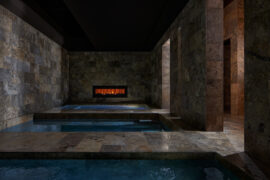Stephen McGarry redefines architecture as an emotive and contextual artform, blending storytelling, material sensitivity, and cultural memory in his shortlisted Bruce Street project.

May 6th, 2025
Welcome to SpeakingOut!, the exclusive interview series hosted by Jan Henderson for the 2025 INDE.Awards. This series shines a light on some of the most thoughtful and creative voices in architecture and design, including past winners, jury members, those shortlisted and category luminaries. This episode is proudly supported by Karndean, our partner in The Building category.
In this installment, we speak with Stephen McGarry, Director at Carr. Based in Melbourne, Stephen has not only played a pivotal role in Carr’s rural Victorian projects but also contributed to works across Ireland, the UK, and Southeast Asia. His recent project, Bruce Street, was shortlisted in the 2024 INDE.Awards in The Building category – and for good reason.

Emotional Architecture
Stephen’s architectural vision is grounded in empathy, storytelling, and cultural context. He believes that architecture should be more than functional – it should shape how people feel, connect, and heal within their environments. His global perspective, drawn from delivering projects in varied social and urban contexts, enriches his ability to approach design as a form of placemaking.
McGarry spoke about the importance of materiality and emotional resonance in his work. For him, good design doesn’t just respond to a site’s physical context – it weaves in layers of social meaning. “Buildings aren’t just structures,” he says. “They can be symbols of division, resilience, loss, and eventually, regeneration.”
A Belfast Childhood Inspired a Lifelong Passion
Stephen’s journey into architecture is rooted in both artistic instinct and personal experience. Growing up in Belfast during a time of significant political unrest, he saw firsthand how buildings could mirror the scars and strengths of a city. These early experiences shaped his desire to pursue architecture not just as a profession, but as a way to engage with and reimagine the world.
“From a very early age, I knew I wanted to be an architect,” he shares. “I’ve always been drawn to shaping the world – physically, socially, emotionally. In Belfast, I saw spaces destroyed, raised, left behind – and slowly, through peace, rebuilt. That’s when I realised the power of architecture in healing and hope.”
Behind the Bruce Street Project
The Bruce Street project, located in Kensington, Melbourne, represents a turning point in the precinct’s built fabric. Situated on a 13-square-metre site, the project had to contend with a context of low-rise warehouses and an adjacent heritage precinct known as the Younghusband site, which is currently being revitalised.

Taking cues from this setting, Carr’s design reflects a tactile, historical materiality while offering something distinctly new. The building, a commercial development, includes best-in-class end-of-trip facilities (EOT), strong street activation, and a sensitivity to scale as it becomes the first of its kind in the Kensington Industrial Park.
“It was the first building of its scale in that pocket, which brought challenges,” says McGarry. “But we leaned into the context – both in material choices and in form – to create something that felt both familiar and forward-looking.”
Designing for Resilience and Regeneration
McGarry’s work demonstrates a commitment to emotionally intelligent architecture – the kind that doesn’t just serve a function but contributes to community wellbeing and cultural continuity. In his view, architects have a responsibility not just to design spaces, but to listen and respond to the stories those spaces hold.

His influence within Carr, especially in shaping the practice’s rural and urban blend of projects, speaks to a growing shift in Australian architecture: one that places as much emphasis on emotional and cultural resonance as it does on environmental and urban strategy.
We extend a warm thank you to Stephen McGarry for sharing his journey, philosophy, and vision with us in this episode of SpeakingOut! His thoughtful reflections remind us that great architecture goes beyond form and function – it connects, transforms, and endures.
Special thanks to our partner Karndean for supporting The Building category at the 2025 INDE.Awards.
Entries to the 2025 INDE.Awards are now closed. Stay tuned for this year’s shortlist announcement on the 12th June 2025.
INDESIGN is on instagram
Follow @indesignlive
A searchable and comprehensive guide for specifying leading products and their suppliers
Keep up to date with the latest and greatest from our industry BFF's!

The undeniable thread connecting Herman Miller and Knoll’s design legacies across the decades now finds its profound physical embodiment at MillerKnoll’s new Design Yard Archives.

A curated exhibition in Frederiksstaden captures the spirit of Australian design

For Aidan Mawhinney, the secret ingredient to Living Edge’s success “comes down to people, product and place.” As the brand celebrates a significant 25-year milestone, it’s that commitment to authentic, sustainable design – and the people behind it all – that continues to anchor its legacy.

London-based design duo Raw Edges have joined forces with Established & Sons and Tongue & Groove to introduce Wall to Wall – a hand-stained, “living collection” that transforms parquet flooring into a canvas of colour, pattern, and possibility.

Carr’s largest residential project to date integrates concrete, steel mesh and landscape across 122 apartments in Melbourne’s Brunswick.

Following the launch of Carr’s Brisbane studio, Director Richard Beel has permanently relocated to lead the practice’s growth across Queensland — supported by a local leadership team and a growing portfolio of projects ahead of the 2032 Olympic Games.

Hogg & Lamb’s Albion Bathhouse has been awarded The Health & Wellbeing Space at the INDE.Awards 2025. The project reimagines the contemporary bathhouse as an immersive architectural journey – one that restores balance through atmosphere, materiality and mindful design.

Adam Markowitz Design, in collaboration with Simeon Dux, has been awarded The Object at the INDE.Awards 2025. Their winning project, A Cabinet of Curiosities, is a masterwork of craftsmanship and adaptability; a poetic response to shifting domestic and professional life in the post-COVID era.
The internet never sleeps! Here's the stuff you might have missed

GEYER VALMONT is launching an innovation hub designed to improve existing interior design capability through enhanced ways of working and industry-leading technology products.

Sydney Open invites the public to explore over 55 buildings, spaces and new additions to the skyline, with a newly released Talks & Tours program offering direct access to the architects behind Bundarra and Pier Pavilion.